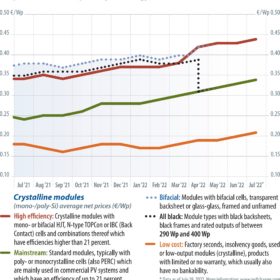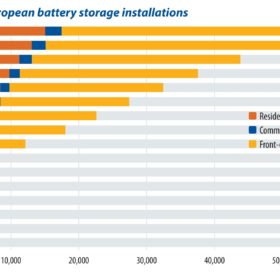Smoothing peaks
There are signs that the northern hemisphere summer of 2022 will be one remembered for its extremes. Heatwaves have descended on Europe and parts of North America, breaking records, causing destructive fires, and costing lives. And an unprecedented energy crisis is looming, with increasingly extreme prices for natural gas and electricity observed in some markets.
Trickle down trouble
In the month of July, the Invesco Solar ETF, an ETF that tracks the MAC Global Solar Energy Index, underperformed relative to the S&P 500 and Dow Jones Industrial. Jesse Pichel of ROTH Capital Partners puts this largely down to high polysilicon prices.
Germany’s revised EEG: New life for PV or dead on arrival?
It has been a few weeks since Germany passed the long-awaited “Easter Package,” the latest iteration of the Renewable Energy Sources Act (Erneuerbare Energien Gesetz, or EEG) which includes far-reaching changes intended to accelerate renewables adoption in Germany. On the whole, writes Martin Schachinger of pvXchange, the praise outweighs the criticism because the act contains numerous improvements and makes life easier for future investors and operators – in theory, at least.
Strong case for energy storage, despite rising costs
Unprecedented volatility in global commodity markets, disruption to logistics and supply chains, and unrelenting growth has driven up the cost of Li-ion batteries since the middle of 2021. Sam Wilkinson and Oliver Forsyth of IHS Markit expect to see rapid manufacturing expansion that will still struggle to keep up with demand, and ultimately lead to the establishment of a smaller group of battery-makers specialized in supplying stationary energy storage systems.
Polysilicon growth lags behind demand
Policy developments worldwide have led to strong growth of renewable energy. Demand from large markets such as Europe, China, and Brazil continues to beat expectations. InfoLink has revised up its module demand forecast to 239-270 GW this year – representing significant growth of up to 34% from last year’s 178 GW of installations. However, analyst Dora Zhao finds that availability of polysilicon could be a major limiting factor in meeting this demand.
Meeting Europe’s growing need
With its move into the mainstream, battery energy storage faces a shifting supply landscape. And within said landscape, opportunities may emerge for chemistries beyond Li-ion and even all new energy storage technologies, writes Jon Ferris, head of flexibility and storage at Delta-EE.
Dawn of virtual transmission
Quick and versatile, batteries are providing a growing number of services to homes, businesses, and on the grid. Electricity network operators are beginning to adopt grid-scale batteries, with the initial applications potentially opening the way for renewable energy to flow more freely and across larger distances than ever before.
History in the making
The urgency of rooftop solar uptake has only been accelerated by the current energy crisis, but the spread of PV to historic and landmarked buildings remains limited. In Europe, historic buildings constructed before 1945 represent at least a quarter of total building stock. To boost uptake, some municipalities are considering a loosening of their protection policies, while researchers are finding interesting byways for installation. Furthermore, building integrated PV solutions are being touted as the ideal compromise between aesthetic continuity and new generation opportunities.
At home on the sea: Marine PV and boats
In 2018, Lyall Burgess and wife Katie started a business called Sun Powered Yachts. The original idea came to them in Tahiti, where the couple had chartered a yacht to explore the French Polynesian island. As Lyall Burgess tells the story, “We were on a charter boat in Tahiti and we were having to run the engine four hours a day to keep up with the fans and the refrigeration. And you’re in this beautiful anchorage, sunshine all day, and have to listen to this engine because the yacht didn’t have any solar panels. So, it kind of all happened at the same time. We found out about these panels, the opportunity was there, we just went for it and created Sun Powered Yachts … and it’s grown ever since.”
Open opportunity for laser processing
Laser contact opening (LCO), a standard process in PERC cell production, has seen little market development in the past few years. Stiff competition from equipment suppliers in Asia, combined with the fact that most new n-type manufacturing doesn’t make use of LCO, has kept the level of interest here quite low. However, as the PV research community increases its focus on reducing silver consumption, new approaches to cell contacting and metallization provide impetus for a second look at laser processing.









